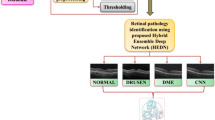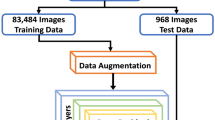Abstract
Retinal diseases are most widely affected by various types of people without any proper reason. Nowadays, many retinal diseases are identified by experts. Detecting retinal diseases in the early stages is very important with better accuracy. Deep learning (DL) techniques are commonly used in the early prediction of retinal disorders. In DL, multiple layers accurately detect abnormalities in the retinal images. Various datasets are also present for this research work. This paper uses a hybrid multilayered classification (HMLC/CNN-VGG19). This system is developed to categorize four kinds of retinal disorders (age-related macular degeneration, choroidal neovascularization, Drusen, diabetic retinopathy, as well as typical cases). The proposed H.M.L.C. is applied to OCT to gather pictures from different data sources, like the U.C.I. repository, Kaggle, etc. The CNN and VGG-19 models used in the H.M.L.C. are implemented in Python over the datasets. The experimental results in terms of classification accuracy are verified. The classification accuracy is high since the H.M.L.C. used the advanced features from CNN and VGG-19 models. The performance is calculated using sensitivity, specificity, F1 score, and accuracy.








Similar content being viewed by others
Data availability
Enquiries about data availability should be directed to the authors.
References
Cheng J, Li Z, Gu Z, Fu H, Wong DWK, Liu J (2018) Structure-preserving guided retinal image filtering and its application for optic disk analysis. IEEE Trans Med Imaging 37(11):2536–2546. https://doi.org/10.1109/TMI.2018.2838550
Dash S, Chowdary PSR, Chakravarthy VVSSS, Raju CG, Sahu G, Charan KS, Umamaheshwar Y (2022) Real time retinal optic disc segmentation via guided filter and discrete wavelet transform. J Phys Conf Ser 2312(1):012007
Hassan B, Qin S, Hassan T, Ahmed R, Werghi N (2021) Joint segmentation and quantification of chorioretinal biomarkers in optical coherence tomography scans: a deep learning approach. IEEE Trans Instrum Meas 70:1–17. https://doi.org/10.1109/TIM.2021.3077988
Huang W et al (2019) Arterial spin labeling images synthesis from sMRI using unbalanced deep discriminant learning. IEEE Trans Med Imaging 38(10):2338–2351. https://doi.org/10.1109/TMI.2019.2906677
Huang L, He X, Fang L, Rabbani H, Chen X (2019) Automatic classification of retinal optical coherence tomography images with layer-guided convolutional neural network. IEEE Signal Process Lett 26(7):1026–1030
Khan Z et al (2021) Diabetic retinopathy detection using VGG–NIN a deep learning architecture. IEEE Access 9:61408–61416. https://doi.org/10.1109/ACCESS.2021.3074422
Li X, Jia M, Islam MT, Yu L, Xing L (2020) Self-supervised feature learning via exploiting multimodal data for retinal disease diagnosis. IEEE Trans Med Imaging 39(12):4023–4033. https://doi.org/10.1109/TMI.2020.3008871
Li X, Jiang Y, Li M, Yin S (2021) Lightweight attention convolutional neural network for retinal vessel image segmentation. IEEE Trans Ind Inform 17(3):1958–1967. https://doi.org/10.1109/TII.2020.2993842
Ma X, Ji Z, Niu S, Leng T, Rubin DL, Chen Q (2020) MS-CAM: multi-scale class activation maps for weakly-supervised segmentation of geographic atrophy lesions in SD-OCT images. IEEE J Biomed Health Inform 24(12):3443–3455. https://doi.org/10.1109/JBHI.2020.2999588
Ma Y et al (2021) ROSE: a retinal OCT-angiography vessel segmentation dataset and new model. IEEE Trans Med Imaging 40(3):928–939. https://doi.org/10.1109/TMI.2020.3042802
Mao Y, He Y, Liu L, Chen X (2020) Disease classification based on synthesis of multiple long short-term memory classifiers corresponding to eye movement features. IEEE Access 8:151624–151633. https://doi.org/10.1109/ACCESS.2020.3017680
Moosavi A et al (2021) Imaging features of vessels and leakage patterns predict extended interval aflibercept dosing using ultra-widefield angiography in retinal vascular disease: findings from the PERMEATE study. IEEE Trans Biomed Eng 68(6):1777–1786. https://doi.org/10.1109/TBME.2020.3018464
Ngo L, Cha J, Han J-H (2020) Deep neural network regression for automated retinal layer segmentation in optical coherence tomography images. IEEE Trans Image Process 29:303–312. https://doi.org/10.1109/TIP.2019.2931461
Playout C, Duval R, Cheriet F (2019) A novel weakly supervised multitask architecture for retinal lesions segmentation on fundus images. IEEE Trans Med Imaging 38(10):2434–2444. https://doi.org/10.1109/TMI.2019.2906319
Rasti R, Rabbani H, Mehridehnavi A, Hajizadeh F (2017) Macular OCT classification using a multi-scale convolutional neural network ensemble. IEEE Trans Med Imaging 37(4):1024–1034
Rong Y et al (2019) Surrogate-assisted retinal OCT image classification based on convolutional neural networks. IEEE J Biomed Health Inform 23(1):253–263. https://doi.org/10.1109/JBHI.2018.2795545
Seebock P, Waldstein SM, Klimscha S, Bogunovic H, Schlegl T, Gerendas BS, Donner R, Schmidt-Erfurth U, Langs G (2018) Unsupervised identification of disease marker candidates in retinal OCT imaging data. IEEE Trans Med Imaging 38(4):1037–1047
Seebock P et al (2020) Exploiting epistemic uncertainty of anatomy segmentation for anomaly detection in retinal OCT. IEEE Trans Med Imaging 39(1):87–98. https://doi.org/10.1109/TMI.2019.2919951
Sekhar BVDS, Jagadev AK (2023) Efficient Alzheimer’s disease detection using deep learning technique. Soft Comput 27:9143–9150. https://doi.org/10.1007/s00500-023-08434-z
Sekhar BVDS et al (2023) Sustainable and reliable healthcare automation and digitization using deep learning technologies. J Sci Ind Res 82(2):226–231. https://doi.org/10.56042/jsir.v82i2.70222
Sekhar BVDS et al (2019) Image denoising using wavelet transform based flower pollination algorithm. In: Information systems design and intelligent applications: proceedings of fifth international conference I.N.D.I.A. 2018 vol 1, pp 391–400
Udayaraju P, Jeyanthi P (2022) Early diagnosis of age-related macular degeneration (A.R.M.D.) using deep learning. Smart Innov Syst Technol 289:657–663
Venkata Subbarao M, Sudheer Kumar T, Chowdary PSR, Chakravarthy VVSSS (2022) Brain tumor classification using decision tree and neural network classifiers. In: Data engineering and intelligent computing: proceedings of 5th I.C.I.C.C. 2021, vol 1, pp 405–412
Wang X et al (2020) UD-MIL: uncertainty-driven deep multiple instance learning for OCT Image classification. IEEE J Biomed Health Inform 24(12):3431–3442. https://doi.org/10.1109/JBHI.2020.2983730
Wang Y et al (2021) Robust content-adaptive global registration for multimodal retinal images using weakly supervised deep-learning framework. IEEE Trans Image Process 30:3167–3178. https://doi.org/10.1109/TIP.2021.3058570
Yan Z, Yang X, Cheng K-T (2018) Joint segment-level and pixel-wise losses for deep learning based retinal vessel segmentation. IEEE Trans Biomed Eng 65(9):1912–1923. https://doi.org/10.1109/TBME.2018.2828137
Funding
The authors have not disclosed any funding.
Author information
Authors and Affiliations
Corresponding author
Ethics declarations
Conflict of interest
Pamula Udayaraju declares that he/she has no conflict of interest, P Jeyanthi declares that he/she has no conflict of interest, and B V D S Sekhar declares that he/she has no conflict of interest.
Ethical approval
This article does not contain any studies with human participants or animals performed by any authors.
Additional information
Publisher's Note
Springer Nature remains neutral with regard to jurisdictional claims in published maps and institutional affiliations.
Rights and permissions
Springer Nature or its licensor (e.g. a society or other partner) holds exclusive rights to this article under a publishing agreement with the author(s) or other rightsholder(s); author self-archiving of the accepted manuscript version of this article is solely governed by the terms of such publishing agreement and applicable law.
About this article
Cite this article
Udayaraju, P., Jeyanthi, P. & Sekhar, B.V.D.S. A hybrid multilayered classification model with VGG-19 net for retinal diseases using optical coherence tomography images. Soft Comput 27, 12559–12570 (2023). https://doi.org/10.1007/s00500-023-08928-w
Accepted:
Published:
Issue Date:
DOI: https://doi.org/10.1007/s00500-023-08928-w




